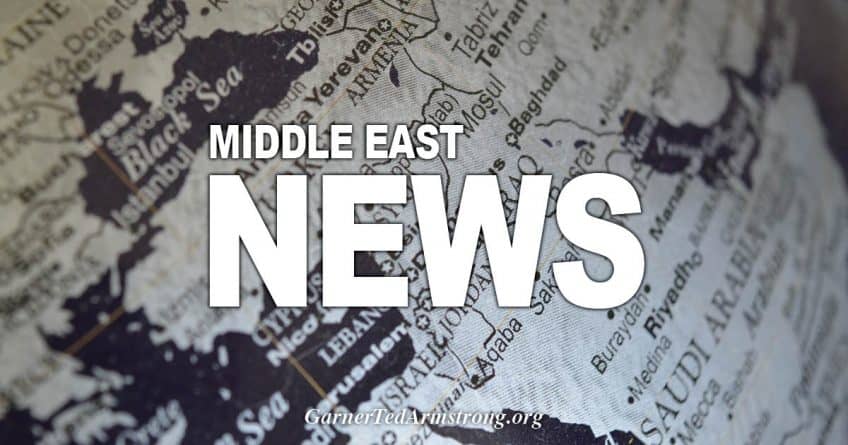The Middle East is experiencing its most severe drought in 900 years, according to NASA– one which is seemingly endless. The drought peaked between 2006-2010, and although 2007, 2009 and 2010 saw “normal” amounts of total rainfall, the region was still in drought.
And therein lies the paradox. A combination of factors, including water management and when the rain falls, means there can still be drought and water scarcity even if it rains a “normal” total amount. If winter rain is typically spread out between November and May, these non-drought-ending rains fell between, say, January and April, often in torrential downpours. This has led to flash flooding of the sort that much of the Middle East has seen this winter, which in turn has led to the erosion of topsoil that farmers rely on for a successful crop. And these extreme drought/flooding events are becoming more frequent.
We all know that water is necessary, and that a lack of water in a country or region is destabilizing. And now we’re watching the fearful possibilities of long-term water instability play out across the Middle East and North Africa. Several countries are experiencing instability or conflict connected to climate change-linked drought:
Syria has been engulfed in violence, a shadow of the former country it once was.
In an Iraq teetering on the edge of stability, water is threatening to topple the order and systems that are in place both in the north, which receives more rainfall, and in the south. Drought coupled with water mismanagement in the south have led to mass protests, specifically in the southern city of Basra, once known as the Venice of the east for its abundance of water. In northern Iraq in the Iraqi Kurdistan region, there are brewing tensions over water between the Kurds and the Iraqis, as well as between the Kurds, Iranians and Turks, who share borders and rivers.
Jordan witnessed their largest anti-government protest in recent years last summer, with water availability as a contributing factor. The protests led to the resignation of Prime Minister Hani al-Mulki, but the unrest has not totally subsided.
Lebanon is on the brink of a water crisis due to a combination of government failures and climate change.
Yemen is continuing to undergo what the United Nations calls the worst humanitarian crisis in the world. The ongoing war and power struggle has been tied to drought and resource mismanagement.
The revolution in Egypt was, too, at least partially connected to climate change impacted water scarcity. As Thomas Friedman writes, the numbers tell the story: “Bread provides one-third of the caloric intake in Egypt, a country where 38 percent of income is spent on food,” notes Sternberg. “The doubling of global wheat prices — from $157/metric ton in June 2010 to $326/metric ton in February 2011 — thus significantly impacted the country’s food supply and availability.” Global food prices peaked at an all-time high in March 2011, shortly after President Hosni Mubarak was toppled in Egypt.
Sudan is in the middle of an ongoing peaceful protest led by women that led to the removal of their longtime dictator, Omar al-Bashir. Weather.com last year that the looming instability in the northern African country was due in part to resource mismanagement and lack of water availability, which in turn has been linked to climate change.
Even the United Arab Emirates, famous for Dubai, the Manhattan of the Middle East, is not without its concerns. A 2005 report said that the UAE had the highest per capita consumption of water in the world. This, coupled with the fact that the water table has dropped about one meter per year for the last 30 years is cause for concern. The situation is not unlike the one that eventually led Jordanians to protest over water and food.
While all of these waves of instability were due to more than just water scarcity, water scarcity is one of the pressures that encourages instability. Take the war in Syrian as an example. When the drought peaked between 2006-2010, farmers started draining any groundwater they could find to tend to their crops. The farmers then depleted the groundwater, which was not replenished by rain. As their new waterless reality took shape, many men moved to larger cities like Hama, Homs and Damascus in search of work to support their families. They found no jobs and ended up living in shanty-towns on the outskirts of the cities, still desperate for work, for money, for sustenance.
One Syrian refugee told weather.com last year, “It would go from not raining at all to raining a lot to the point that it caused small floods,” and that the government did not provide support to all of the farmers who needed it.
As Friedman wrote in 2013, “Since the first cry of ‘Allahu akbar,’ we all joined the revolution. Right away,” an activist told him. Was this about the drought, he asked her. “Of course,” she said, “the drought and unemployment were important in pushing people toward revolution.”
The trend of climate change prompting agricultural desperation leading to migration is becoming more prevalent. There are often other steps in this breakdown. Climate change factors could lead to other forms of scarcity, too, which leads to radicalization or often conflict, thus resulting in migration. “Most people don’t realize how much climate affects everything, from their property values to how hard people work,” Solomon Hsiang, a professor of public policy at the University of California, Berkeley, told Rolling Stone.
Climate data indicates that the rain in the Middle East primarily comes from two directions (and I’m oversimplifying this): there’s the rain that moves over the Mediterranean Sea and then brings rain to parts of Israel, Lebanon and Syria, and there’s the rain and melted snow that moves downwards from the mountains in Iraq, filling the rivers that flow through parts of the Fertile Crescent.
Much of the rain in the region comes off the Mediterranean in the west and moves eastward. As the system moves eastward, it becomes weaker and less rain falls. So even when there isn’t a drought, a place like Raqqa averages less annual rainfall than places farther west like Damascus.
Or, put in more geopolitical terms, there are heavy rains in areas that are closer to the coast and less water inland, until eventually the rain just doesn’t make it there, as is illustrated in the map of rainfall through the land formerly known as the British Mandate over TransJordan. Tel Aviv and Jerusalem receive more rain than Amman. And Amman receives more rain than Basra, Iraq, which is on a similar latitude to the aforementioned two cities.
Water scarcity exacerbated by climate change has only made more apparent what’s been present throughout history, as articulated by Joshua Landis, a professor at the University of Oklahoma: that identity and water are inextricably tied in the region.
“The identities of the Middle East can really be understood in a simple map of a big Arabian Desert around which are sprinkled those cities on the coastline, with their own ships of the sea — the camels being the ships,” he says.
Speaking to weather.com for the Exodus series, Landis breaks down the Middle East in geographic and weather terms: “The Fertile Crescent is an upside down horseshoe that spreads through Israel up through Lebanon, Syria, over to where the Kurds are and then down the Tigris and Euphrates to Basra.”
The desert cities are “a string of cities like a pearl necklace encircl(ing) the vast desert. They demarcated two different societies and ways of life: those who were settled and derived their incomes from agriculture in the rain fed regions of the Fertile Crescent and those who pursued a more nomadic existence.”
Landis explained that “the Bedouin and their caravans were the ships of the desert, carrying goods between the cities sprinkled around the great expanse of the desert, just as the Mediterranean Sea served to connect the many city states that surrounded it. The cities served as entrepôts where goods were exchanged between the desert and sown and where the different communities came together. They were divided into quarters marked out by each community, and had Jewish, Armenian, Kurdish, Christian, Shia, and Sunni quarters.”
Interestingly, ISIS’ trajectory indicates that they played into the narrative of defending Sunni interests, a Brookings Institute study found, which means they were also conquering wetter territory. At its peak, the ISIS state in 2015 pushed up against the rain-line cities and took the desert cities, the cities of the Bedouin tribal Sunni part of that region. This is not a coincidence, according to Landis: it had everything to do with both water and identity.
All of this isn’t to say that the conflict in the Middle East are the sole outcome of identity clashes and water scarcity, but rather to illustrate that these factors, often overlooked in shorter conversations, are vital pieces to this larger puzzle of instability in the region. The ripple effects of these two factors are proving catastrophic, both in the Middle East and globally. And as the long term climate forecast is for more heat and more water scarcity, it’s likely that more conflict, more instability, more war and more refugees are coming.
[Disclaimer]









